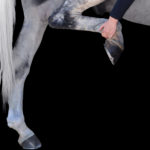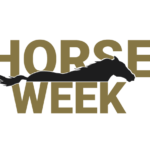April 8, 2002 — Finally, it’s over. The seemingly eternal Winter Equestrian Festival ended at last this afternoon, but not with a whimper.
The folks who couldn’t wait to get out of town missed a heck of a class. The $150,000 Budweiser American Grand Prix Association Championship, the circuit finale, included many of the top U.S. horses — among them Oh Star, Hidden Creek’s Perin and defending AGA champ Ilian. Jose (Pepe) Gamarra designed quite a course to test all of them, and don’t think it was easy for him to come up with the right layout on the big grass field at the Palm Beach Polo Equestrian Club.
Pepe had to take into account the fact that it has been a long circuit and the horses are tired. At the same time, he also needed to make sure the course was championship caliber. The trick came in achieving that “without trying to kill anybody,” as he told me.
Only three from the first round of 30 (one horse, one rider, all grands prix should be that way) got by without faults. The unique, made-for-TV format called for a jump-off that brought back the top 8 horses, however, which also included one with two time faults and four 4-faulters.
The fastest clear in the first round was Margie Goldstein Engle on Perin, her 2000 Olympic mount. That gave her an advantage in the jump-off, because it entitled her to be the last to go, and she gauged her ride perfectly.
With no other double clears, she decided to try for another perfect trip, no matter how long it took. The result was 2 time penalties — uncharacteristic for Margie — but the winning edge, as it turned out. Taking a deliberate approach to the 5-foot, 3-inch final vertical really paid off.
“I thought the last jump was very tough. It was tall, and they were getting a little tired by then,” she pointed out.
“I was almost a little too careful,” Margie laughed afterwards. “I got further over the time than I wanted to.”
But even without a double clear, she was pleased with her horse, a big bay with a nice, alert look.
“He jumped beautifully and just gave a fantastic effort,” she enthused. “When a horse jumps that good, it’s hard to be upset with time faults. A lot of times, this class is won just by going without jumps down.”
Perin has really improved since the Sydney Games, and he’s always had great scope. He needed it today, too. Just as the 4A-B double at the Invitational was the make-it or break-it question there, the triple combination in front of the VIP tent was the big stumbling block here.
Two-thirds of the class faulted somewhere among the forest of orange and black fences that came off a short turn and took some horses by surprise. The combination started out with a huge triple bar, 5 feet high and 6 feet wide, then went two strides to a vertical and out one stride later over an oxer stretching 5-6. It presented something of an optical illusion, with latticework on the sides that had a number of horses looking through the combo, and rails that all seemed to blend together.
The vertical caught Ilian, whose owner/rider, Schuyler Riley, had been pointing toward an AGA victory for the second year in a row. She rested her gelding throughout the Palm Beach segment of the WEF because she knew she was automatically qualified for the AGA.
“I like the back-to-back thing because it shows consistency,” she said, referring to trying to win twice. “And I’ve nearly done it about three times. I was second at the Gold Cup the year after I won it; I was third at the Invitational the year after I won it.”
While Schuyler noted her blaze-faced bay was a bit fresh, having not done much jumping this year, she said, approaching the triple “I didn’t come in exactly like I wanted, he was a little playful before it, and then it was difficult for him to make it over 8B. It was a little miscommunication between horse and rider.”
There was no such problem in the tiebreaker, where she kept all the poles in place.
“It was a blast to ride in the jump-off,” said Schuyler. “It was mostly galloping; a fun, fast track.” All that galloping paid off with a time of 45.893 seconds, the fastest in the tiebreaker to go with her score of 4 faults, carried over from the first round.
The 13-foot, 6-inch-wide water obstacle, used only in the first round, also had its share of victims, including Todd Minikus with Oh Star.
“It was a incredibly bad ride to it,” said Todd, blaming himself for the error.
“I had to add (strides) twice, and then really kick him.” His time of 46.470 to go with a clear trip in the second round was good enough for third.
The biggest disappointment was Ireland’s Kevin Babington on his 2001 European Championships team gold medal mount, Carling King. He had a great first round, and was working on his second clear in the jump-off when he crashed through the final fence. The crowd’s sympathies were with Kevin, who couldn’t figure out what happened.
“It’s almost like his hind end gave on him,” said Kevin, who wound up fifth with two time faults, in addition to the knockdown. “I thought I was home free.”
His time for the tiebreaker was slower than that of Californian Richard Spooner, who had 2 times faults in the first round, and 4 penalties for a knockdown in the jump-off to finish fourth behind Minikus.
Oddly, while riders came from all over for the class, the first three finishers were not only from Florida, but more specifically, from Wellington and environs, which pleased the die-hard spectators who came out for one last Sunday afternoon of jumping this season.
While the competition was exciting, questions remain about when and where the championship should be held. Most of the riders I spoke with felt the circuit should end with the Invitational. Having to return from Tampa to Wellington for one more week is a bit of an anti-climax, no matter how good the championship is.
I asked Gene Mische, the brains behind festival management firm Stadium Jumping, whether he wanted to move the championship to Las Vegas, where he’s hoping the National Horse Show can relocate this fall. Gene said he’d consider it, but not this year, since he wants to get the lay of the land in Vegas. It probably does need to be the closing act of the chronological year, though, because it’s an end-of-season championship that just doesn’t seem to belong in April.
The championship has always been kind of a stepchild. It started in 1985 as a team event held during December in Tampa, staying there through 1989. After that, it moved to the National Horse Show at the Meadowlands in New Jersey, before heading south to Wellington in February. Riders said that date was too early in the season, so it was changed to the end of the circuit when it was run in Tampa two years ago, before it wound up back in Wellington.
The prize money this year was cut in half because Gene was worried about the recession and how well-attended the Festival would be post Sept. 11.
“I’m just disappointed it went from $300,000 to $150,000,” said Todd, as irrepressible as his chestnut stallion, who announced his presence in the ring by rearing and bucking so hard he almost unseated his rider.
“I don’t care where they have it, as long as it goes back to $300,000,” Todd added. “Let’s hold it on Tuesday at 9 o’clock.”






